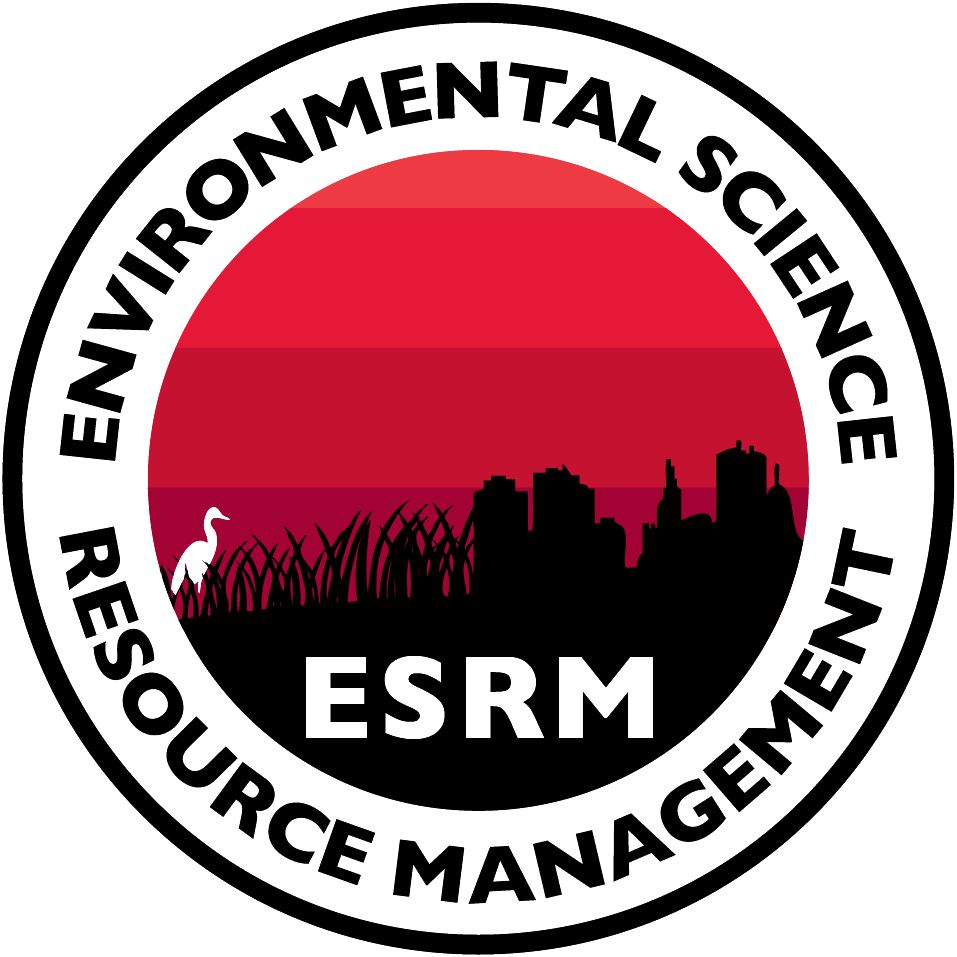Come help us build an innovative coastal conservation & management program here in SoCal
We are currently seeking a
Coastal/Environmental Data Analytics & Visualization
Assistant Professor
Environmental Science and Resource Management Program
California State University Channel Islands
See our brief videos about our tenure track position here (a few are below)
Position Description:
CSU Channel Islands (CSUCI) invites applicants for the position of Assistant Professor of Environmental Science and Resource Management. CSUCI seeks an energetic, innovative colleague interested in deepening our commitment to data artistry, big data analytics and visualization, and in making substantial contributions to our growing campus. The successful candidate should have a strong record of teaching, research, and service (or be able to provide strong evidence of their promise in each of those areas) and demonstrated proficiency with turning large or complex data sets into engaging, usable information via a variety of digital tools. We are particularly interested in candidates with two or more of the following disciplinary interests: coastal zone management, energy systems, climate science, big data, visual rhetoric, atmospheric science, water resource management, ecotoxicology, environmental justice, sustainability science, or conservation technologies. Candidates should have strong digital/methodological skills spanning both proprietary (Adobe Creative Suite, ArcGIS, Tableau, Matlab, Flourish, etc.) and open source (R, GitHub, MySQL, D3.js, Audacity, etc.) platforms, as well as experience or substantial interest in interpreting California’s coastal zone. CSUCI is the newest campus in the California State University system, with our main campus located in coastal Ventura County (between Santa Barbara and Los Angeles) at the interface of protected areas, agricultural zones, and urban cores. Many responses to our local environmental and social challenges have become templates outside our region, e.g., recovery of endangered species, sea level rise adaptation, farmworker protections, offshore energy regulation, marine protected area networks, and smart growth land use policies. All of these efforts have benefited from strong, data-based argumentation. The successful candidate will help us continue this tradition by augmenting our existing research efforts with new external funding and community collaborations. We are a Hispanic Serving Institution dedicated to serving our diverse student body and surrounding community while promoting interdisciplinary inquiry, strong community engagement, and an international focus; candidates are expected to share those commitments. A Ph.D. or terminal degree in Environmental Science, Ecology, Geosciences, Hydrology, Anthropology, Applied Statistics, Digital Design, Data Journalism, or a related field is required. The successful candidate will join us for our Fall 2019 semester.
For additional information and to apply please visit:
https://www.csucifacultyjobs.com/, go to the Search Jobs tab, & query for
“Environmental Science and Resource Management”
Application review begins on December 14, 2018
Owing to our recent fires, gun violence, etc. across our region and the associated campus closures, our application review has been pushed back to begin on January 2, 2019. Full consideration will be given to all applications received by January 1, 2019.
Please direct any and all questions to our chair:
Dr. Sean Anderson’s cell: (805) 732-2732 & email: ESRMSearch@gmail.com
Our rationale behind this new data-focused faculty position:
General Background/Context
The term “data artist” has been slowly growing in usage in recent decades, but is nowhere as widely used as the related terms of big data, data scientist, or data journalist. This recognition is slowly growing, however, as our increasingly visual world demands professionals with skills spanning data interpretation, argumentation, and visual aesthetics.
Using visual art to elucidate patterns and depict the complexities of natural and anthropogenic data is not new. Many of us were first introduced to data artistry by Dr. Edward Tufte’s decades-long exploration of data visualization. Tufte often begins his lectures (including those he gave to our students over CSUCI’s first decade) with Charles Minard’s famous map of Napoleon’s disastrous Russian campaign of 1812 as a quintessential example of a data-dense but aesthetically engaging visualization which merges six data sets into an elegant, two-dimensional graphic (below).
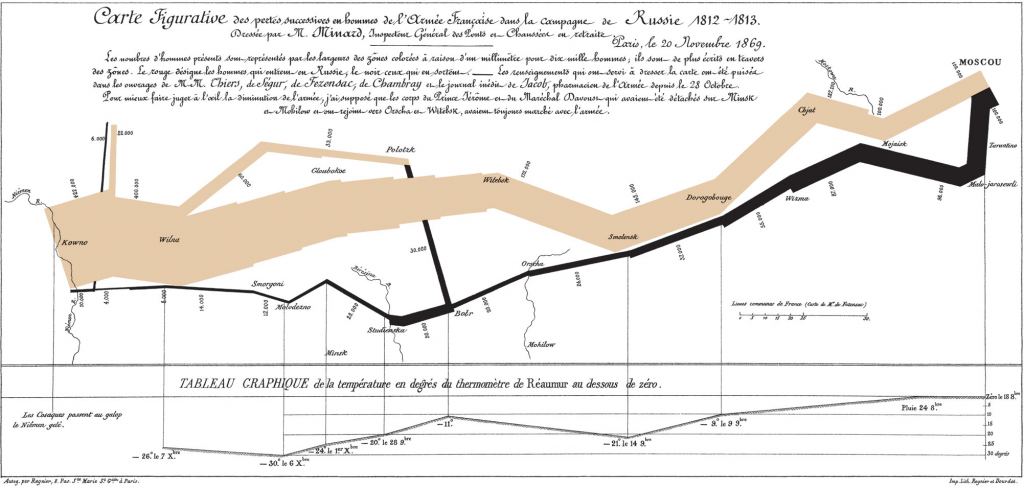
“Napoleon’s Russian campaign of 1812” by Charles Joseph Minard 1861, originally published in Emile Cheysson’s l’Album of 1869.
Olivier Meyer likens data artistry to “painting with data.” Data artistry is a fundamentally iterative craft which combines knowledge of the subject matter, a strong facility with audience perception/visual rhetoric, and deft command of new digital analytical and graphical tools. Dr. Philip Meyer argues that a data artist can “process data at two levels:
- analysis to bring sense and structure out of the never-ending flow of data, and
- presentation to get what’s important and relevant into the [the public’s] head…[and] disclose methods and present findings in a way that can be verified by replication.”
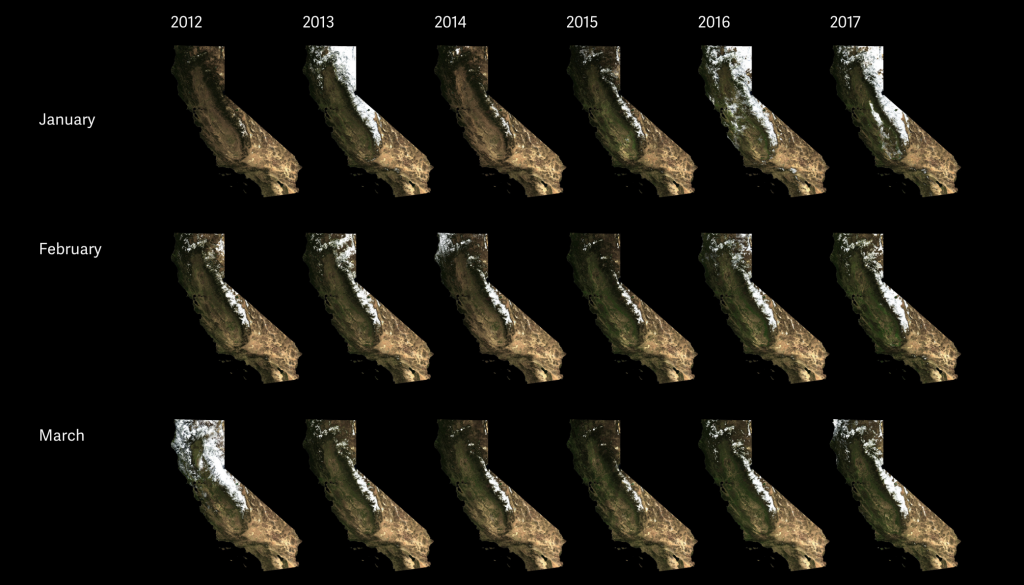
“What the six-year drought did to California in 93 maps and two charts” (detail) by David Yanofsky for Quartz.
Quantitative environmental data has historically been scarce with most of our energies devoted to sampling the world around us and collecting that information bit by bit. While this will always remain a key endeavor, we are rapidly transitioning into an era wherein information is abundant, and elegant processing/organizing/interpreting is of ever-increasing importance. Our students now have easy access to tremendous palettes of data spanning everything from satellite-collected vegetation data to U.S. decadal census data to historic pollution measurements across the California coast. Indeed, armed with expansive survey areas, evermore powerful autonomous mapping tools, and growing invitations to collaborate on a wide variety of management challenges, our faculty and students are more often than not adding to this firehose of data. CSUCI is therefore both an ideal incubator to develop new coastal data analytics and visualizations and a potential source for innovative pedagogy supporting this emerging craft.
Meeting Our Current Need
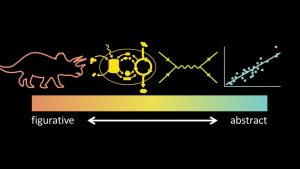
Excerpt from Jen Christiansen’s 2018 talk at the Guild of Natural Science Illustrators.
Our new faculty colleague would deepen student facility with exploring complex datasets and translating quantitative data into elegant, engaging presentations of that information. In addition to fostering those specific skills, our new colleague would be fantastically positioned to help us continue our efforts to underpin our institutional pillar of interdisciplinarity across campus programs and as such a key step to fostering integrative studies across programs as our young campus enters our adolescence (we could have said “as our campus continues to mature,” but our ESRM Program is rarely described as mature).
Our just-completed campus-wide revamping of General Education courses–and in particular our new, more rigorous criteria–has created an opportunity (and possibly need) for refreshed cross-disciplinary faculty who can easily bring to bear skills from outside of their traditional, core disciplinary focus.
In addition, this position will directly benefit faculty and faculty-student scholarship throughout campus with this new data artist potentially supporting/collaborating on numerous data-intensive and community-focused research projects across CSUCI. Examples of existing research efforts that could potentially benefit from collaboration with a visualization expert include:
-
- CSU Channel Islands Coastal Opinion Survey (longitudinal polling conducted each fall for more than a decade with >40 questions and >1,000 respondents per year)
-
- CSU Channel Islands Beach Sustainability Index (integrating dozens of variables collected over several year from >40 beaches across SoCal)
-
- Social Media Sentiment Analysis (exploring how various events such as oil spills or political revelations are interpreted differently by different demographics)
-
- Sustainability Language Mapping (exploring the various terms different regions and languages utilize when characterizing various behaviors, products and systems)
-
- Plasticization of the Pacific Ocean (combining various published data sets with CI-generated data quantifying inflow/accumulation of marine debris across the Pacific)
-
- Sense of Place Mapping (Chumash Language Geodesy merged with Feeling Maps of Santa Rosa Island visitors)
- Environmental History of SoCal Wetlands (integrating maps, agricultural records, landscape photography, and journal/newspaper records from Ranchero Period to WWI)
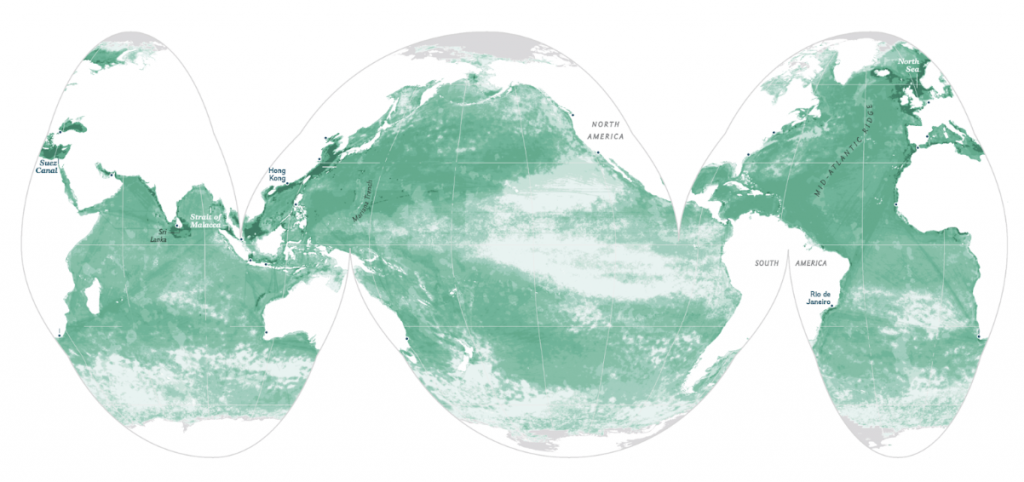
“Spatial and Temporal Changes in Cumulative Human Impacts on the World’s Ocean” by National Geographic Maps. Data source: Halpern, et al. 2016. & UNEP-WCMC, World Database on Protected Areas.
Background on CSU Channel Islands:
CSU Channel Islands is the newest addition to the 23-campus California State University System, the largest public university system in the United States with a half million students. Our campus formally opened in 2002, registering our first freshman class in 2004. Our 1,193 acre main campus in Camarillo, California is home to (as of Fall 2017) approximately 6,800 undergraduate and 250 graduate students with enrollment slated to more than double at full campus build-out. Additional facilities include our recently-opened Santa Rosa Island Research Station, Channel Islands Harbor Boating Center, and satellite campuses in Thousand Oaks, Santa Barbara, and Goleta. Placing students at the center of the educational experience, CSU Channel Islands provides undergraduate and graduate education that facilitates learning within and across disciplines through integrative approaches, emphasizes experiential and service learning, and graduates students with multicultural and international perspectives.
We are proud of our commitment educate students historically underserved in higher education. CSU Channel Islands is a federally designated Hispanic Serving Institution, ranked 19th on the most recent “Top 50 Colleges for Hispanic Students” list. Well over half of our students come from groups traditionally underrepresented in university education; 61% are women, 60% first generation college goers, 50% are Latinx, 48% eligible for Pell Grants (a proxy for low-income), and 7% active duty military or veterans. Our innovative, award-winning Veterans Resource Center has been key to making our campus more welcoming to our active duty and former military students.
CSU Channel Islands has been a “Great College to Work For” by the Chronicle of Higher Education five of the past ten years, ranks 97th on the Sierra Club’s “Cool Schools” list, has been an Arbor Day Foundation “Tree Campus USA” for the past nine years, is a Princeton Review “Green College,” and placed onto President’s Higher Education Community Service Honor Roll for the seven straight years.
General Background on the ESRM Program:
The ESRM Program houses applied ecology, field science, coastal science, geomorphology, and interdisciplinary natural resource management efforts here at CSU Channel Islands. The ESRM Program has a strong focus on both the wildland-urban interface and the coastal zone, drawing heavily upon these interface zones for both scholarship and educational orientation. Our program places the utmost importance on exceptional undergraduate teaching. The ESRM Major has a strong interdisciplinary curriculum emphasizing ecological restoration, GIS, land use, field methods, conservation mechatronics/robotics, human dimensions of resource management, and conservation biology after two years of basic coursework in biology, chemistry, geosciences, and economics. Many of our courses stress technical writing and communication, undergraduate research, and service learning. All our students complete a mandatory year-long research project prior to graduation.
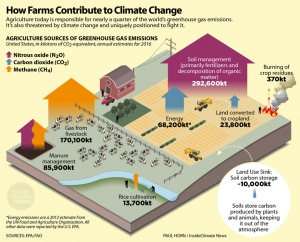
An excerpt from Paul Horn’s graphic for the ICN series Harvesting Peril.
While our program is small, faculty and student research teams nevertheless work on a variety of projects in a variety of systems including riparian and wetland restoration, rapid ecological assessments, habitat fragmentation, hydrogeomorphology, fire ecology, avian ecology, coastal fisheries, coastal geomorphology, engaging underserved populations with protected areas, water quality, ecotoxicology, seafood sustainability, public perceptions of coastal resources, sea level rise adaptation, coastal resource valuation, coastal contaminants, and management of sandy beaches. We have been a trailblazer in our region and state with regards to Unmanned Aerial Systems (aka drones) and Remotely Operated Vehicles (ROVs), creating the policies and procedures used throughout higher ed. That capacity will continue to expand across both our scholarship and teaching over the coming years. Our teaching, research, and service tends to focus on our local (southern California) coastal zone with particular emphases on the Santa Monica Mountains (where our main campus resides), the Southern California Bight, and Santa Rosa Island (home to our field station). Keeping with our university’s international emphasis, ESRM faculty also conduct research and teach courses in systems outside of California such as New Orleans, coastal Louisiana, Costa Rica, Hawai’i, the Cook Islands, and Turkey. We are currently developing a Professional Science Master’s Program, expected to begin within the next two years. Our program’s epicenter in the newly-opened Sierra Hall brings together most of our computer lab, research spaces, and classrooms under one roof.
What the heck is “ESRM”?!?:
When we were designing our new campus in the early 2000s, we began by questioning our traditional academic silos and organization. One of our founding programs endeavored to bridge the divide between traditional environmental science (inquiry that often emphasized quantification of pollutants and other gross environmental variables from a chemical, physical, or other such natural science perspective) and resource management (which generally emphasized the human dimensions of utilizing valuable biological materials such as cattle, trees and fish). We ultimately created something of a chimera we call Environmental Science and Resource Management that we feel best reflects our educational and professional approaches.
Further Info and Examples of ESRM Activities:
please note: these webpages are being overhauled and may change frequently
ESRM Conventional Program Page: http://esrm.csuci.edu/
ESRM Main Program Page, designed for our students: https://esrm.zone/
Teaching Examples:
Example Student Videos: http://esrm.csuci.edu/videos/
Representative Lectures: http://tinyurl.com/pc6c8vs
Sample Syllabi: http://esrm.csuci.edu/syllabi.htm
Sample Stories About Our Student & Community-Centered Efforts:
http://tinyurl.com/pep7ffc, http://tinyurl.com/qezxvlc, http://tinyurl.com/pvdon24,
http://tinyurl.com/p7b2qul, http://tinyurl.com/k9m647m, http://tinyurl.com/nfdfk4n,
Sample ESRM Research and Service Learning Class Blogs:
Service Learning in New Orleans: http://nola.piratelab.org
Service Learning in the Cook Islands: http://cooks.piratelab.org
Service Learning in Costa Rica: http://cr.esrm.zone/
Oil Spill Ecotoxicology: http://oil.piratelab.org
Aerial and Aquatic Robotic Research: http://aarr.piratelab.org


